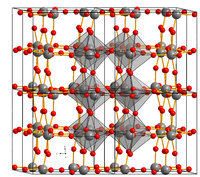
Photo from wikipedia
This study investigated the performance of UV light active TiO2 and UV–visible light active WO3/TiO2 nanoparticles as air purifying materials that can be potentially applied to urban green infrastructures such… Click to show full abstract
This study investigated the performance of UV light active TiO2 and UV–visible light active WO3/TiO2 nanoparticles as air purifying materials that can be potentially applied to urban green infrastructures such as rain gardens and pervious pavements. Using a laboratory-scale continuous gas flow photoreactor, the removal efficiency of gaseous nitrogen oxide (NOx) by two different photocatalytic nanoparticles coated on natural zeolites and pervious concrete blocks was evaluated. The results showed that the TiO2- and WO3/TiO2-coated zeolites are excellent photoactive materials providing enhanced air purification function (~95% removal efficiency of NOx) under UV and UV–visible light irradiation, respectively. In contrast, both of the TiO2- and WO3/TiO2-coated pervious concrete blocks showed a measurable NOx removal (~60%) only under UV irradiation, whereas the visible light activity of the WO3/TiO2-coated concrete block was significantly reduced (~20%) mainly due to the decrease in the photocatalytic reaction sites for visible light. This study revealed the potential utility of photocatalytic nanoparticles in improving urban air quality, in the form of the surface component of various urban infrastructures.
Journal Title: International Journal of Environmental Science and Technology
Year Published: 2017
Link to full text (if available)
Share on Social Media: Sign Up to like & get
recommendations!